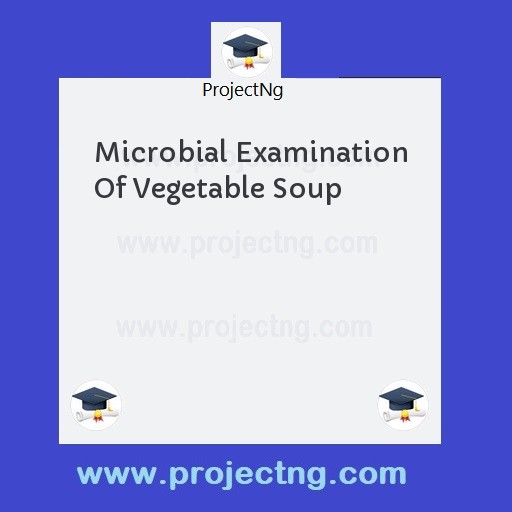Microbial Examination Of Vegetable Soup
Science Lab Technology Project Topics
Get the Complete Project Materials Now! »
MICROBIAL EXAMINATION OF VEGETABLE SOUP
ABSTRACT
Microbiological examination of vegetable group was conducted and pour plate method was used. 0.1ml of the sample was poured on MacConkey agar media. The highest bacterial isolation was Corguebacterium sepedonicum with 31CFU (40%) which followed by Pseudomonas salauaceanm with 25CFU (33%), while the least isolated bacterial organism was Erwinia carotovora with 21CFU (27%). The bacterial load of the sample vegetable soup was 77CFU. The high frequency of bacteria and fungi, was bacteria because they are present as normal flora of humans food and contaminate the vegetable soup as a result of poor hygienic and unsatisfactory by sanitation.
CHAPTER ONE
1.0 INTRODUCTION
1.1 BACK GROUND OF THE STUDY
Vegetable soup is a generally warm soup that is made by combining ingredients such as meat, vegetable with stock, water, pepper, Onions, palm oil and others liquid. Vegetable soup are characterized by boiling solid and liquid ingredients in a pot until the flavours are extracted. Vegetable soups are eaten in a variety of ways as part of main meals and snacks.
Francis et al., (2001), point out that vegetable soup are consumed for their nutritional and medicinal benefits. The nutritional content of vegetable soup aeries considerably, though generally they contain little protein or fat and varying proportions of vitamins such as vitamin A, vitamin K and vitamin B6, provitamins, dietary minerals and carbohydrates.
In southern Nigeria because of their pleasant taste the leaves are generally considered as a great soup that has high concentration of icon and used by anemia patients to build up the blood cells (Ladeji et al., 1998).
1.2 AIMS OF THE STUDY
i) To ascertain microbial safety of vegetable soup
ii) To isolate micro-organisms associated with vegetable soup
iii) To Identify the microbial types
iv) To determine the microbial load of the sampled vegetable soup
v) To determine the microbial load, of each type
1.3 STATEMENT OF THE PROBLEM
Annous et al., (2005), explain that vegetable soup contains micro-organisms some of which are pathogenic and other are non-pathogenic. Moreover Wiswanathan et al., (2001). Highlight that the pathogenic micro-organisms in vegetable soup produce serious threat to the safety of the consumer and reduces quality as well as the acceptability of the products in vegetable soup. The above statements have prompted the need for a project work on bacteriological examination of vegetable soup.
1.4 SIGNIFICANCE OF THE STUDY
The results of this project work would reveal the microbial safety of vegetable soup. The results would equally reveal if the microbial load of the sampled vegetable soups was high or low and if the microbial types involved were pathogenic or not. If the microbial load was high and the microbial types were pathogenic, then hygienic practices were not observed during the preparation of the vegetable soups and should be introduced. But if the microbial load was low, the microbial types were pathogenic, then hygienic practices were observed during the preparation of the vegetable soups and should be encouraged.
1.5 LIMITATION THE STUDY
This project was limited to microbial examination of vegetable soup.
Another problem encounter was poor Financial status on my part as a student which was a big problem during the project work.
Moreover, the cost of media and reagents was high, thus limiting the number of samples ran during the project analysis.
Be the First to Share On Social

Enjoying our content?
Don't miss out on new videos! Subscribe to our YouTube channel for more awesome content.
Subscribe Now!













